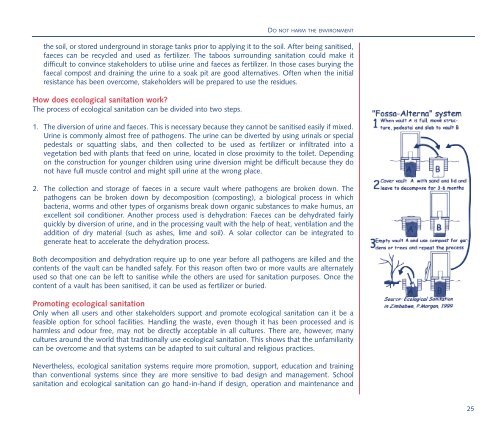Child-Friendly Hygiene and Sanitation Facilities in Schools
Child-Friendly Hygiene and Sanitation Facilities in Schools
Child-Friendly Hygiene and Sanitation Facilities in Schools
Create successful ePaper yourself
Turn your PDF publications into a flip-book with our unique Google optimized e-Paper software.
the soil, or stored underground <strong>in</strong> storage tanks prior to apply<strong>in</strong>g it to the soil. After be<strong>in</strong>g sanitised,<br />
faeces can be recycled <strong>and</strong> used as fertilizer. The taboos surround<strong>in</strong>g sanitation could make it<br />
difficult to conv<strong>in</strong>ce stakeholders to utilise ur<strong>in</strong>e <strong>and</strong> faeces as fertilizer. In those cases bury<strong>in</strong>g the<br />
faecal compost <strong>and</strong> dra<strong>in</strong><strong>in</strong>g the ur<strong>in</strong>e to a soak pit are good alternatives. Often when the <strong>in</strong>itial<br />
resistance has been overcome, stakeholders will be prepared to use the residues.<br />
How does ecological sanitation work?<br />
The process of ecological sanitation can be divided <strong>in</strong>to two steps.<br />
DO NOT HARM THE ENVIRONMENT<br />
1. The diversion of ur<strong>in</strong>e <strong>and</strong> faeces. This is necessary because they cannot be sanitised easily if mixed.<br />
Ur<strong>in</strong>e is commonly almost free of pathogens. The ur<strong>in</strong>e can be diverted by us<strong>in</strong>g ur<strong>in</strong>als or special<br />
pedestals or squatt<strong>in</strong>g slabs, <strong>and</strong> then collected to be used as fertilizer or <strong>in</strong>filtrated <strong>in</strong>to a<br />
vegetation bed with plants that feed on ur<strong>in</strong>e, located <strong>in</strong> close proximity to the toilet. Depend<strong>in</strong>g<br />
on the construction for younger children us<strong>in</strong>g ur<strong>in</strong>e diversion might be difficult because they do<br />
not have full muscle control <strong>and</strong> might spill ur<strong>in</strong>e at the wrong place.<br />
2. The collection <strong>and</strong> storage of faeces <strong>in</strong> a secure vault where pathogens are broken down. The<br />
pathogens can be broken down by decomposition (compost<strong>in</strong>g), a biological process <strong>in</strong> which<br />
bacteria, worms <strong>and</strong> other types of organisms break down organic substances to make humus, an<br />
excellent soil conditioner. Another process used is dehydration: Faeces can be dehydrated fairly<br />
quickly by diversion of ur<strong>in</strong>e, <strong>and</strong> <strong>in</strong> the process<strong>in</strong>g vault with the help of heat, ventilation <strong>and</strong> the<br />
addition of dry material (such as ashes, lime <strong>and</strong> soil). A solar collector can be <strong>in</strong>tegrated to<br />
generate heat to accelerate the dehydration process.<br />
Both decomposition <strong>and</strong> dehydration require up to one year before all pathogens are killed <strong>and</strong> the<br />
contents of the vault can be h<strong>and</strong>led safely. For this reason often two or more vaults are alternately<br />
used so that one can be left to sanitise while the others are used for sanitation purposes. Once the<br />
content of a vault has been sanitised, it can be used as fertilizer or buried.<br />
Promot<strong>in</strong>g ecological sanitation<br />
Only when all users <strong>and</strong> other stakeholders support <strong>and</strong> promote ecological sanitation can it be a<br />
feasible option for school facilities. H<strong>and</strong>l<strong>in</strong>g the waste, even though it has been processed <strong>and</strong> is<br />
harmless <strong>and</strong> odour free, may not be directly acceptable <strong>in</strong> all cultures. There are, however, many<br />
cultures around the world that traditionally use ecological sanitation. This shows that the unfamiliarity<br />
can be overcome <strong>and</strong> that systems can be adapted to suit cultural <strong>and</strong> religious practices.<br />
Nevertheless, ecological sanitation systems require more promotion, support, education <strong>and</strong> tra<strong>in</strong><strong>in</strong>g<br />
than conventional systems s<strong>in</strong>ce they are more sensitive to bad design <strong>and</strong> management. School<br />
sanitation <strong>and</strong> ecological sanitation can go h<strong>and</strong>-<strong>in</strong>-h<strong>and</strong> if design, operation <strong>and</strong> ma<strong>in</strong>tenance <strong>and</strong><br />
25

















